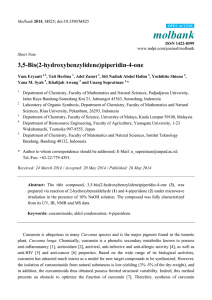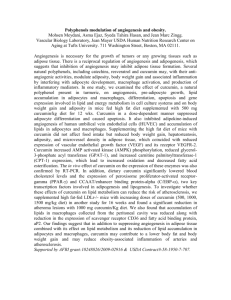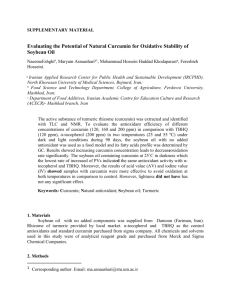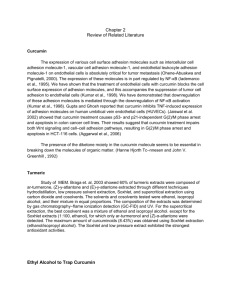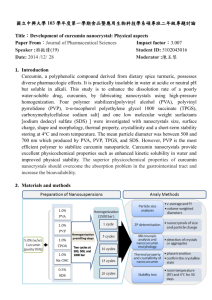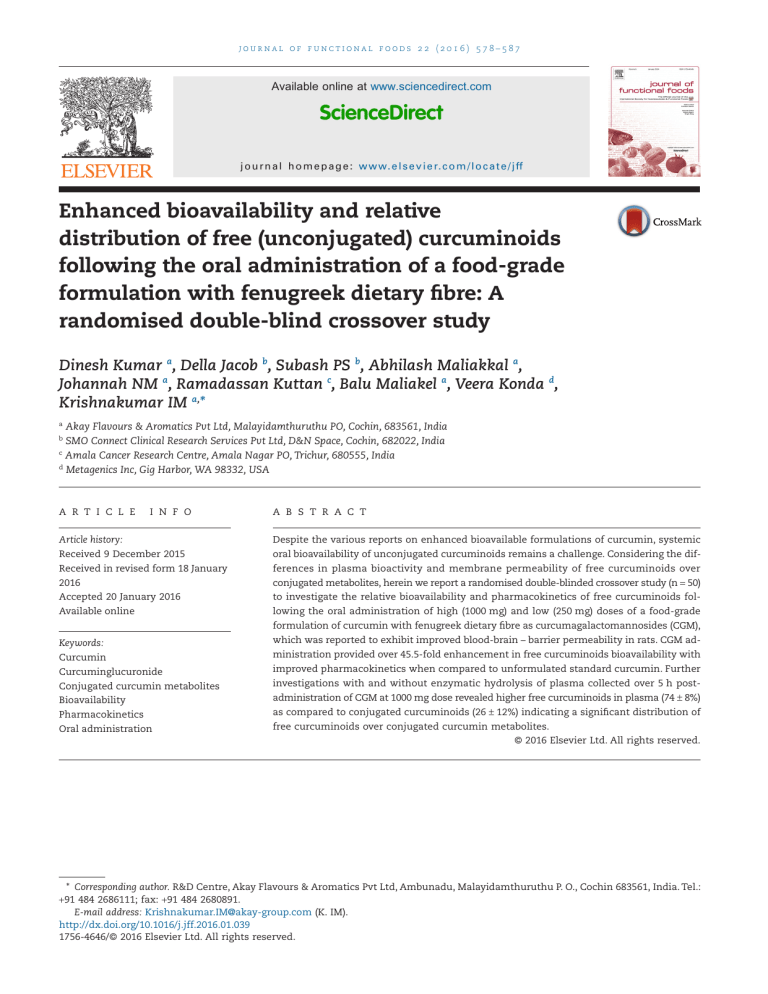
journal of functional foods 22 (2016) 578–587
Available online at www.sciencedirect.com
ScienceDirect
j o u r n a l h o m e p a g e : w w w. e l s e v i e r. c o m / l o c a t e / j ff
Enhanced bioavailability and relative
distribution of free (unconjugated) curcuminoids
following the oral administration of a food-grade
formulation with fenugreek dietary fibre: A
randomised double-blind crossover study
Dinesh Kumar a, Della Jacob b, Subash PS b, Abhilash Maliakkal a,
Johannah NM a, Ramadassan Kuttan c, Balu Maliakel a, Veera Konda d,
Krishnakumar IM a,*
a
Akay Flavours & Aromatics Pvt Ltd, Malayidamthuruthu PO, Cochin, 683561, India
SMO Connect Clinical Research Services Pvt Ltd, D&N Space, Cochin, 682022, India
c
Amala Cancer Research Centre, Amala Nagar PO, Trichur, 680555, India
d
Metagenics Inc, Gig Harbor, WA 98332, USA
b
A R T I C L E
I N F O
A B S T R A C T
Article history:
Despite the various reports on enhanced bioavailable formulations of curcumin, systemic
Received 9 December 2015
oral bioavailability of unconjugated curcuminoids remains a challenge. Considering the dif-
Received in revised form 18 January
ferences in plasma bioactivity and membrane permeability of free curcuminoids over
2016
conjugated metabolites, herein we report a randomised double-blinded crossover study (n = 50)
Accepted 20 January 2016
to investigate the relative bioavailability and pharmacokinetics of free curcuminoids fol-
Available online
lowing the oral administration of high (1000 mg) and low (250 mg) doses of a food-grade
formulation of curcumin with fenugreek dietary fibre as curcumagalactomannosides (CGM),
Keywords:
which was reported to exhibit improved blood-brain – barrier permeability in rats. CGM ad-
Curcumin
ministration provided over 45.5-fold enhancement in free curcuminoids bioavailability with
Curcuminglucuronide
improved pharmacokinetics when compared to unformulated standard curcumin. Further
Conjugated curcumin metabolites
investigations with and without enzymatic hydrolysis of plasma collected over 5 h post-
Bioavailability
administration of CGM at 1000 mg dose revealed higher free curcuminoids in plasma (74 ± 8%)
Pharmacokinetics
as compared to conjugated curcuminoids (26 ± 12%) indicating a significant distribution of
Oral administration
free curcuminoids over conjugated curcumin metabolites.
© 2016 Elsevier Ltd. All rights reserved.
* Corresponding author. R&D Centre, Akay Flavours & Aromatics Pvt Ltd, Ambunadu, Malayidamthuruthu P. O., Cochin 683561, India. Tel.:
+91 484 2686111; fax: +91 484 2680891.
E-mail address: Krishnakumar.IM@akay-group.com (K. IM).
http://dx.doi.org/10.1016/j.jff.2016.01.039
1756-4646/© 2016 Elsevier Ltd. All rights reserved.
journal of functional foods 14 (2015) 215–225
Available online at www.sciencedirect.com
ScienceDirect
j o u r n a l h o m e p a g e : w w w. e l s e v i e r. c o m / l o c a t e / j ff
Improved blood–brain-barrier permeability and
tissue distribution following the oral
administration of a food-grade formulation of
curcumin with fenugreek fibre
Krishnakumar IM a,*, Abhilash Maliakel a, Gopakumar G a,
Dinesh Kumar a, Balu Maliakel a, Ramadasan Kuttan b
a
b
Akay Flavours & Aromatics Ltd., R&D centre, Ambunadu, Malayidamthuruthu P.O., Cochin 683561, India
Amala Cancer Research Centre, Amala Nagar P.O., Trichur 680555, India
A R T I C L E
I N F O
A B S T R A C T
Article history:
The delivery of significant concentrations of biologically active free curcuminoids (curcumin,
Received 3 December 2014
demethoxycurcumin and bisdemethoxycurcumin) at the target tissues has always been re-
Received in revised form 29 January
garded as a major limitation for the efficacy of curcumin. Herein we report the blood–brain-
2015
barrier permeability, tissue distribution and enhanced bioavailability of free curcuminoids
Accepted 30 January 2015
following the oral administration of a food grade curcumin formulation in comparison with
Available online
the standardized native curcumin, for the first time. UPLC-ESI-MS/MS analyses of postadministration tissue samples of Wistar rats (200 mg/kg body weight) demonstrated significant
Keywords:
(p < 0.001) enhancement in plasma bioavailability (25-fold), in vivo stability and blood–brain-
Curcumin
barrier permeability as evidenced from the tissue distribution of free curcuminoids at, (ng/
Oral bioavailability
g), brain (343 ± 64.7), heart (391.7 ± 102.5), liver (445.52 ± 83), kidney (240.1 ± 47.2), and spleen
Functional food
(229.72 ± 42.2), with extended elimination half-life of 3 to 4 h. Standard curcumin, on the
Blood–brain-barrier
other hand, detected only 1.4 ± 0.8 ng/g of curcumin in the brain tissues.
Tissue distribution
© 2015 Published by Elsevier Ltd.
Pharmacokinetics
1.
Introduction
Curcuminoids, the yellow pigment molecules of the kitchen
spice turmeric (Curcuma longa L.), have shown to possess a wide
spectrum of health beneficial pharmacological activities and
safety profile suitable for the plausible development as a therapeutic agent and/or functional food ingredient for the
prevention, control and/or treatment of a variety of proinflammatory diseases (Gupta, Patchva, & Aggarwal, 2013;
Hamaguchi, Ono, & Yamada, 2010; Hasima & Aggarwal, 2012;
Nishikawa, Tsutsumi, & Kitani, 2013). Chemically, curcumin is
characterized as a bis-α,β-unsaturated β-diketone polyphenol, [1,7-bis(4-hydroxy-3-methoxyphenyl)-1,6-heptadiene-3,5dione], and its commercially available natural form (commonly
referred to as ‘standard curcumin’) is a mixture of three
curcuminoids: curcumin (72 to 78%), demethoxycurcumin,
(DMC, 12 to 18%) and bisdemethoxycurcumin, (BDMC, 3 to 8%)
with purity of ≥95%. The significant pleiotropic effect emanating from its ability to interact and modulate multiple molecular
* Corresponding author. R&D Centre, Akay Flavours & Aromatics Ltd, Ambunadu, Malayidamthuruthu P.O., Cochin-683561, India. Tel.: +91
484 2686111; fax: +91 484 2680891.
E-mail address: krishnakumar.im@akay-group.com (Krishnakumar IM).
http://dx.doi.org/10.1016/j.jff.2015.01.049
1756-4646/© 2015 Published by Elsevier Ltd.
Food &
Function
View Article Online
Published on 10 November 2014. Downloaded by University of Utah on 29/11/2014 05:21:48.
PAPER
Cite this: DOI: 10.1039/c4fo00749b
View Journal
Enhanced bioavailability and safety of
curcumagalactomannosides as a dietary ingredient
Vijayasteltar B. Liju,a Kottarapat Jeena,a Dinesh Kumar,b Balu Maliakel,b
Ramadasan Kuttana and Krishnakumar IM*b
In spite of the various bioavailable formulations of curcumin for pharma and dietary supplement applications, food grade formulations suitable as a dietary ingredient, and capable of providing significant
levels of plasma curcumin, are limited. The present contribution describes the safety and oral bioavailability of a novel water soluble formulation of curcumin, curcumagalactomannosides (CGM), when used as
a dietary ingredient in selected food items. CGM was prepared using a food grade hydrocolloid (galactomannans) derived from the kitchen spice fenugreek (Trigonella foenum graccum), without using any synthetic excipients. The safety of the formulation was assessed through acute and subchronic toxicity
studies on Wistar rats and genotoxicity studies. The efficacy of CGM as a bioavailable dietary ingredient
was assessed by successfully preparing various food items and by measuring the post-blood plasma curcumin levels at various time intervals after the consumption of food items. High performance liquid
chromatography coupled with a photodiode array detector (HPLC-PDA) and electrospray ionization
Received 19th August 2014,
Accepted 9th November 2014
DOI: 10.1039/c4fo00749b
www.rsc.org/foodfunction
1.
tandem mass spectrometer (ESI-MS/MS) was employed for the quantification of plasma curcuminoids. It
was observed that CGM is safe and suitable for further development and clinical studies, with a no observable adverse effect level (NOAEL) up to 2.0 g kg−1 per day b.wt. CGM was found to offer seven to ten
times higher bioavailability of curcumin in humans, when incorporated into various food/beverage items
at 100 mg CGM per serving size, as compared to the standard unformulated curcumin.
Introduction
Curcuma longa L. (Turmeric) is a popular kitchen spice that
has been widely used in Indian curries and medicinal preparations for thousands of years. Modern scientific research
have identified many bioactive compounds in turmeric rhizomes, in which curcumin or diferuloylmethane, [1,7-bis[4-hydroxy-3-methoxyphenyl]-1,6-heptadiene-3,5-dione],
a
hydrophobic polyphenolic compound, has been characterized
as the most active component responsible for numerous
health beneficial pharmacological effects.1,2 Observational
studies have already delineated the dietary intake of turmeric
with a reduced incidence of chronic diseases such as Cancer
and Alzheimer’s in the subcontinent of India.3,4 With more
than 3000 preclinical investigations on various aspects of
cancer, curcumin stands as one of the best studied natural products to date; a significant promising candidate capable of
selectively modulating multiple cell signaling pathways.1–4
a
Department of Biochemistry, Amala Cancer Research Centre, Amala Nagar, 680555
Thrissur, Kerala, India
b
Research and Development Centre, Akay Flavours & Aromatics Pvt Ltd, Cochin
683561, Kerala, India. E-mail: krishnakumar.im@akay-group.com;
Fax: +91 484 2680891; Tel: +91 484 2686111
This journal is © The Royal Society of Chemistry 2014
Considering the multi-targeted mechanism of action of this
promiscuous natural agent of immense therapeutic value, curcumin has emerged as an ‘yellow gold’.5 Though some food/
beverage products containing curcumin are available today,
the number of branded food products containing physiologically relevant amounts of curcumin per serving is limited due
to the very low solubility and stability of curcuminoids in water
and oil.2,6 The solubility of curcumin in aqueous buffer at pH
5.0 has been reported to be as low as 11 ng mL−1.6 In addition,
the poor systemic oral bioavailability of curcumin (due to its
extremely low aqueous solubility, high hydrolytic instability
and rapid enzymatic in vivo degradation) has also been a
major limitation against the development of curcumin as
a functional food ingredient or therapeutic agent.2,6,7
While the uptake and distribution of curcumin in the body
is essential for its biological activity, curcumin offers only negligible quantities in plasma due to the poor absorption, permeability and rapid metabolism.2,7 The consumption of even
10 to 12 g of curcumin as capsules was reported to provide
only less than 50 ng mL−1 of curcumin in human plasma.8
Several attempts to overcome the problem of poor bioavailability of curcuminoids, comprising the use of adjuvants to inhibit
in vivo enzymatic degradation, the formation of nanoparticles,
and the formulation of phospholipid complexes and lipo-
Food Funct.
Author's personal copy
JOURNAL OF FUNCTIONAL FOODS
4 ( 2 0 1 2 ) 3 4 8 –3 5 7
Available at www.sciencedirect.com
journal homepage: www.elsevier.com/locate/jff
An enhanced bioavailable formulation of curcumin
using fenugreek-derived soluble dietary fibre
Krishnakumar IMa,*, Abhilash Ravia, Dinesh Kumara, Ramadasan Kuttanb,
Balu Maliakela
a
Akay Flavours & Aromatics Ltd., R&D Centre, Ambunadu, Malayidamthuruthu P.O., Cochin 683561, India
Amala Cancer Research Centre, Amala Nagar P.O., Thrissur 680 555, India
b
A R T I C L E I N F O
A B S T R A C T
Article history:
Poor intestinal absorption has been regarded as a major limiting factor for the therapeutic
Received 20 June 2011
use of curcumin, the primary active constituent of turmeric. Herein, we investigated the
Received in revised form
bioavailability of a novel formulation of curcumin-impregnated soluble dietary fibre disper-
23 December 2011
sions (BR213 curcumagalactomannosides) comprising an extensive gel forming and non-
Accepted 4 January 2012
digestible soluble galactomannan fibre derived from the spice fenugreek. The dispersions
Available online 8 February 2012
were prepared as microgranulates of mean particle size 150 ± 20 lm by an ultrasound mediated gel-phase dispersion technique. In vitro release studies at pH 1.2 and 6.8 showed slow
Keywords:
and prolonged release of colloidal curcumin from the amorphous microgranulates of cur-
Bioavailability
cumin-impregnated soluble fibre. Enhanced bioavailability of the new formulation was fur-
Curcumin
ther demonstrated in animals (Wistar rats) and human volunteers in comparison with
Controlled-release
unformulated curcumin. It was observed that the relative absorption of curcumin from
Fenugreek
Soluble fibre
Ultrasound
the novel fibre formulation, as evident from the area under curve calculations, was 20 times
higher in animals and 15.8 times higher in humans when supplemented orally. Maximum
absorption was also found to be prolonged as compared to the unformulated curcumin.
2012 Elsevier Ltd. All rights reserved.
1.
Introduction
Turmeric (Curcuma longa L.), belonging to the family of
Zingiberaceae, is a perennial herb native to India where its
rhizome is used as a yellow colorant curry spice and traditional
medicine. The active principle in turmeric was identified as a
group of polyphenolic compounds, namely curcumin (74–
78%), demethoxycurcumin (15–18%) and bisdemethoxycurcumin (4–6%) commonly referred to as ‘curcumin’ (Aggarwal,
Kumar, Aggarwal, & Shishodia, 2004, chap. 23). Numerous preclinical and clinical evaluations have confirmed many interesting bioactivities of curcumin in various disease states,
including thrombosis (Srivastava, Dikshit, Srimal, & Dhawan,
1985), myocardial infarction (Nirmala & Puvanakrishnan,
1996), arthritis (Funk et al., 2006), rheumatism (Deodhar, Sethi,
& Srimal, 1980), Alzheimer’s disease (Yang et al., 2005), Crohn’s
disease (Holt, Katz, & Kirshoff, 2005), diabetes (Arun & Nalini,
2002) and in various types of cancer (Aggarwal, Kumar, &
Bharti, 2003; Dorai & Aggarwal, 2004; Hsu & Cheng, 2007;
Kunnumakkara, Anand, & Aggarwal, 2008; Ruby, Kuttan, Babu,
Rajasekharan, & Kuttan, 1995). Curcumin is hepato- and nephroprotective (Kiso, Suzuki, Watanabe, Oshima, & Hikino, 1983;
Venkatesan, Punithavath, & Arumugam, 2000) with a strong
capacity to reduce proliferation of a variety of malignant cells,
to induce apoptosis and to suppress tumour initiation, promotion and metastasis (Dorai & Aggarwal, 2004; Kunnumakkara
et al., 2008). Curcumin has shown to act mainly by downregulating the transcription factors like NF-jB, which leads to
* Corresponding author: Tel.: +91 484 2686111; fax: +91 484 2680891.
E-mail address: krishnakumar.im@akay-group.com (Krishnakumar IM).
1756-4646/$ - see front matter 2012 Elsevier Ltd. All rights reserved.
doi:10.1016/j.jff.2012.01.004

